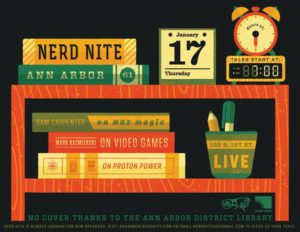 For NNA2 #61, we’ll be diving into MRIs and what we can and cannot learn about the brain with neuroscience researcher Sam Carpenter, exploring how protons are structured, inside and out, with physics grad student Nicole Lewis, and talking about why we play – or don’t play – video games with Mark Kazmierski. So come pick up some facts you didn’t know before and use ‘em to wow your non-Nerd Nite A2 friends! As always, it’s free, courtesy of the Ann Arbor District Library, so grab a friend, grab a drink, and enjoy another informal/informative evening at NNA2!
For NNA2 #61, we’ll be diving into MRIs and what we can and cannot learn about the brain with neuroscience researcher Sam Carpenter, exploring how protons are structured, inside and out, with physics grad student Nicole Lewis, and talking about why we play – or don’t play – video games with Mark Kazmierski. So come pick up some facts you didn’t know before and use ‘em to wow your non-Nerd Nite A2 friends! As always, it’s free, courtesy of the Ann Arbor District Library, so grab a friend, grab a drink, and enjoy another informal/informative evening at NNA2!
When: Thursday, 1/17/2019
Doors at 6:30, talks at 7 pm
Where: LIVE, 102 S. First St.
Cost: Free! Gee, thanks, AADL!
 Sam Carpenter – MRI: Magic Really-cool Images
Sam Carpenter – MRI: Magic Really-cool Images
We often hear in the media about some new scientific study where “brain scans reveal something interesting” But often, not a lot of effort goes into describing what is meant by a “brain scan”, how they work and what they can tell us. A common method of “brain scan” is Magnetic Resonance Imaging (MRI). I’ll be breaking down what an MRI is, how they work and what we can and cannot learn about the brain.
About Sam: I am a Pennsylvania native who relocated to Portland, OR in 2010 where I started working in behavioral neuroscience research at Oregon Health & Science University. My technical experience with MRI physics via Penn State set me up to be a part of one of the largest longitudinal neuroimaging adolescent studies at the time. On the job, I learned how to code in a variety of languages, build and run image processing pipelines as well as how to talk ADHD children still for 2+ hrs in the MRI machine. I have scanned over ~1000 individuals ranging in age from 12 days to 88 years. I started in an M.S. program in Bioinformatics at OHSU in 2016 but withdraw in order to move with my spouse to Ann Arbor for a career opportunity. Check me out on Twitter @carpensa1.
 Mark Kazmierski – Game On! Why you do (or don’t) Play Video Games
Mark Kazmierski – Game On! Why you do (or don’t) Play Video Games
What makes games so addictive. In a world of over-stimulation and short attention spans, what makes games the thing that we are drawn to? We will attempt to break down what keeps people playing, as well as what prevents people from getting started.
About Mark: A 29-year-old gamer who has playing since he had the strength to lift a controller, Mark Kazmierski has always had just as much an interest in the culture and development of games as he does playing them. He’s no gaming professional, he’s just a regular guy with enthusiasm about something he loves. Follow him @Kazman2007.
 Nicole Lewis – Unpacking the Proton
Nicole Lewis – Unpacking the Proton
Scientists have known since the 60s that the proton is made of smaller particles called quarks and gluons that are tightly bound together by the strong nuclear force. This process is responsible for 98% percent of the mass of the visible universe. Which would be great if we had any idea how it worked. I study proton-proton collisions that are at a high enough energy that the proton breaks up into a spray of particles. By studying the particles that come out of this spray and how they are arranged in space, we can learn more about the internal structure of the proton
About Nicole: Nicole is a physics PhD student at the University of Michigan studying the structure of the proton and part of the PHENIX collaboration at Brookhaven National Lab. When not thinking about work, she spends most of her time thinking about Harry Potter, Buffy the Vampire Slayer, and Dungeons and Dragons.